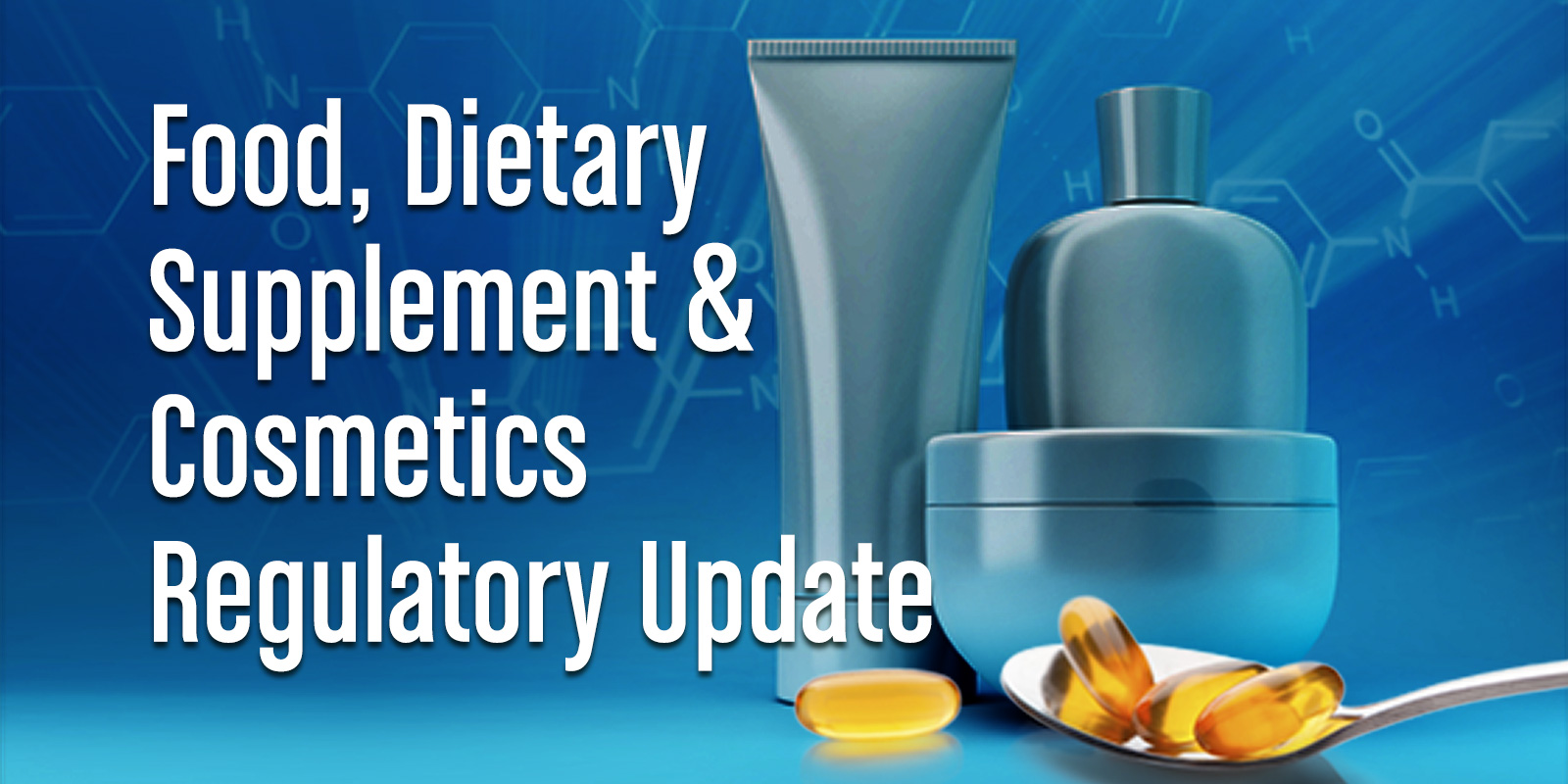
Food, Dietary Supplement & Cosmetics Update | Vol. IV, Issue 3
Top News
FDA Amends Waivers to Sanitary Transportation Rule
On April 6, 2017, the Food and Drug Administration ("FDA") notified industry regarding the amendment of waivers available under the Sanitary Transportation of Human and Animal Food rule ("Sanitary Transportation Rule"). Specifically, FDA has made some clarifications to the language previously used, such as modifying the language of the waivers to clarify their applicability only to businesses subject to the requirements of 21 CFR part 1, subpart O, and specifying that the Grade "A" milk waiver applies to the transportation of bulk and finished Grade "A" milk products only. FDA also clarified the food establishment waiver for businesses that provide food directly to consumers to better express the types of businesses within its scope, and to incorporate established definitions in 21 CFR 1.227 to describe the food establishments for which this waiver is available (i.e., restaurants, retail food establishments, and nonprofit food establishments). Additionally, FDA has revised the waiver language to make clear that it applies to receiving and delivery operations of a food establishment that are part of the normal business operations of the establishment, and has modified the language of theFDA has also granted a waiver for businesses that are appropriately certified and are inspected under the requirements established by the Interstate Shellfish Sanitation Conference's National Shellfish Sanitation Program ("NSSP"), but only when such businesses are engaged in transportation operations involving molluscan shellfish in vehicles that are permitted by the state NSSP certification authority.
The waivers are effective as of April 6, 2017.
FDA and Federal Partners Issue New Five-Year Food Safety Analytics Strategic Plan
On March 24, 2017, FDA, USDA's Food Safety and Inspection Service, and the Centers for Disease Control and Prevention issued their second Strategic Plan for years 2017–2021. The strategic plan is part of the agencies' Interagency Food Safety Analytics Collaboration ("IFSAC") to "improve coordination of federal food safety analytic efforts and address cross-cutting priorities for food safety data collection, analysis, and use."
Under the new strategic plan, IFSAC will focus on "continuing to improve estimates of the sources of foodborne illnesses and developing methods to estimate how these sources change over time." The plan outlines key objectives to achieve three main goals: (i) to improve the use and quality of new and existing data sources; (ii) to improve analytic methods and models; and (iii) to enhance communication about IFSAC progress.
FDA Recognizes DUNS Number for Importer Identification
On March 31, 2017, FDA issued a guidance formally recognizing the Data Universal Numbering System ("DUNS") number as an acceptable unique facility identifier ("UFI") for importers responsible for meeting the requirements of the Foreign Supplier Verification Programs ("FSVP") rule. The final FSVP rule, which requires that importers perform certain risk-based activities to verify that food imported into the United States has been produced in a manner that meets applicable U.S. safety standards, previously indicated that FDA might consider DUNS numbers as acceptable UFI(s). FDA stated, "the identification of importers will help the FDA effectively implement, monitor compliance with, and enforce the FSVP requirements."
EU Adopts Official Controls Regulation
On April 7, 2017, Regulation (EU) 2017/625 on official controls and other official activities performed to ensure the application of food and feed law, animal health and welfare rules, and plant health and plant protection products ("Regulation") was published in the Official Journal of the EU. This Regulation is aimed at aligning and harmonizing rules for inspections by EU competent authorities, as well as at boosting the fight against food fraud in the European Union. The Regulation will enter into force on April 27, 2017, and partially apply as of December 14, 2019. Other compliance dates apply. For example, the provisions of the regulation for establishing an EU reference laboratory are applicable from April 29, 2018.
EFSA Publishes its Annual Activity Report for 2016
On March 30, 2017, the European Food Safety Authority ("EFSA") published its Annual Activity Report presenting the outcomes and results of its 2016 activities. Among other items, the Report highlights the publication by EFSA of close to 500 scientific outputs in fields such as antimicrobial resistance, microplastics and nanoplastics in food, the reevaluation of food colors, novel foods, the cumulative risk assessment of pesticides, and the dietary reference values for vitamins. The report also highlights the introduction of EFSA's Strategy 2020, which translates the key priorities of EFSA's work into strategic objectives and illustrates how EFSA will face the opportunities and challenges of the coming years. The strategy also introduces EFSA's new mission statement "Trusted science for safe food," which is meant to reflect the essence of its work: providing independent scientific advice to EU risk managers to ensure safe food for European citizens.
EFSA Consults on Draft Guidance for the Assessment of Feed Additives
On April 6, 2017, EFSA opened for public consultation its draft guidance for the assessment of the safety of feed additives for target species. This document aims to complement Regulation (EC) 429/2008 to support applicants in the preparation and submission of an application and technical dossier for the authorization of a feed additive in accordance with Regulation (EC) No 1831/2003. The EFSA draft guidance aims to encourage the reduction and replacement of tests using experimental animals. For this purpose, the draft guidance provides a list of feed additives for which safety can be presumed without additional studies. For all other additives, the EFSA draft guidance recommends as a first step the assessment of the safety of the feed additive by an extensive literature review. The draft guidance recommends that applicants use toxicity data (existing or new) from repeated dose studies in laboratory animals or conduct tolerance studies in target animals only if safety cannot be established through literature searches. Comments are due May 31, 2017.
European Commission Implements a Coordinated Pesticides Control Program for 2018, 2019, and 2020
On April 7, 2017, the Commission Implementing Regulation 2017/660 ("Regulation") was published in the Official Journal of the EU. The Regulation is a coordinated multiannual control EU program for years 2018, 2019, and 2020, to ensure compliance with maximum residue levels of pesticides and to assess the consumer exposure to pesticide residues in and on food of plant and animal origin. This Regulation is intended to monitor pesticides contained in foodstuffs over a series of three-year cycles to allow consumer exposure and the application of EU legislation to be assessed. The Regulation requires that EU Member States, throughout these years, take and analyze samples for the pesticide/product combinations as listed in Annex I to the Regulation. Such samples include, for example, the presence of 2-Phenylphenol, acephate, biphenyl, or glyphosate in wheat grains, bananas, or broccoli, for 2018.
Other News
U.S. senators introduced the "Food Security is National Security Act of 2017" bill, which, if passed, would add the Secretary of Agriculture and the Secretary of Health and Human Services as members of the Committee on Foreign Investment in the United States and would require the Committee to consider the security of the food and agriculture systems of the United States as a factor when determining whether to take action with respect to foreign investment.
FDA announces it is investigating new label statements to make the presence of milk more clear on food products suitable for lactose-intolerant individuals but unsuitable for milk-allergic individuals.
Regulatory Updates
FDA Issues Technical Amendments to Importer Food Regulations
In the March 30, 2017, Federal Register, FDA amended its prior notice of imported food regulations to reflect a change in the electronic data interchange system and its expanded capabilities, to correct inaccurate number designations in section headings, and to reflect a change in an FDA office name. This action is ministerial or editorial in nature. The rule was effective March 30, 2017.
Upcoming Meetings, Workshops, and Conferences
Public Meeting of the National Organic Standards Board to assist the United States Department of Agriculture in the development of standards for substances to be used in organic production and to advise the Secretary of Agriculture on any other aspects of the implementation of Organic Foods Production Act, April 13, 2017, via webinar, and April 19–21, 2017, in Denver, CO.
Public Meeting of the Agricultural Marketing Service's ("AMS") Plant Variety Protection Board to discuss a variety of topics including, but not limited to, work and outreach plans, subcommittee activities, and proposals for procedure changes, April 27, 2017, in Washington, D.C.
Public Meeting of the AMS's Fruit and Vegetable Industry Advisory Committee, May 9-10, 2017, in Arlington, VA.
Public Meeting of FDA, titled "International Cooperation on Cosmetics Regulation (ICCR)—Preparation for ICCR-11 Meeting," July 12–14, 2017, in Brasilia, Brazil.
Jones Day publications should not be construed as legal advice on any specific facts or circumstances. The contents are intended for general information purposes only and may not be quoted or referred to in any other publication or proceeding without the prior written consent of the Firm, to be given or withheld at our discretion. To request reprint permission for any of our publications, please use our "Contact Us" form, which can be found on our website at www.jonesday.com. The mailing of this publication is not intended to create, and receipt of it does not constitute, an attorney-client relationship. The views set forth herein are the personal views of the authors and do not necessarily reflect those of the Firm.




